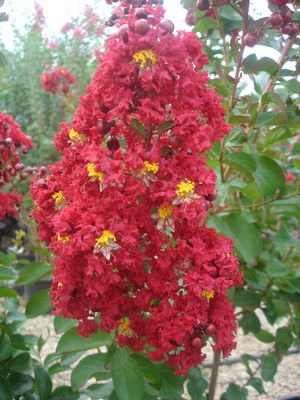Print This Page
Crape Myrtle, Dynamite
Lagerstroemia indica 'Dynamite'
PP#10296
Lagerstroemia is a genus with over 50 species and numerous cultivars to offer trees, shrubs, and weeping shrubs that can be utilized for just about any purpose in the landscape. Crape Myrtles are primarily grown for their long-lasting blooms – up to 120 days! Most species also have a smooth bark that sheds thin layers throughout the year, uncovering inner bark that is shades of gray or even cinnamon-red.
Flowers begin to emerge in the early summer after foliage, in panicles of crinkled small flowers with a crepe-like feel and look. They last longer if the plant is not terribly overwatered. When the blooms finally being to drop, they are followed by a large number of capsule fruits that can weigh down the branches. If it’s still early in the ear, prune the fruits to promote another round of flowering. If untrimmed, the large green fruits will dry out, turning into black husk that split open to release numerous small seeds.
Blooms only appear on new branches, so it’s not uncommon to prune them in the winter. Unfortunately, larger specimens are often butchered back severely to encourage additional branches and many more blooms. Since most crape myrtles recover nicely, they are routinely victimized by those without taste.
Simple opposite green leaves emerge early in the spring, and vary in size according to the cultivar. They turn a lovely shade of red, orange, or yellow in the fall. Crape Myrtles appreciate moist soils, but tolerate dry conditions once they are established.
 |
Blooming Tree |
 |
Accent Tree |
Flower Color:Dark Red
|
 |
Height15 Feet
|
 |
Spread15 Feet
|
USDA Hardiness Zone 7
Available Sizes:
| Item |
Description |
| CRA-DYN-05 |
#005 CRAPE MYRTLE, DYNAMITE (RED) |

|
| CRA-DYN-15 |
#015 CRAPE MYRTLE, DYNAMITE (RED) |

|
Characteristics & Attributes
|
Deer Tolerance
|
Exposure
|
Habit
|
Water Needs
|
|
Soil pH Preference
|







